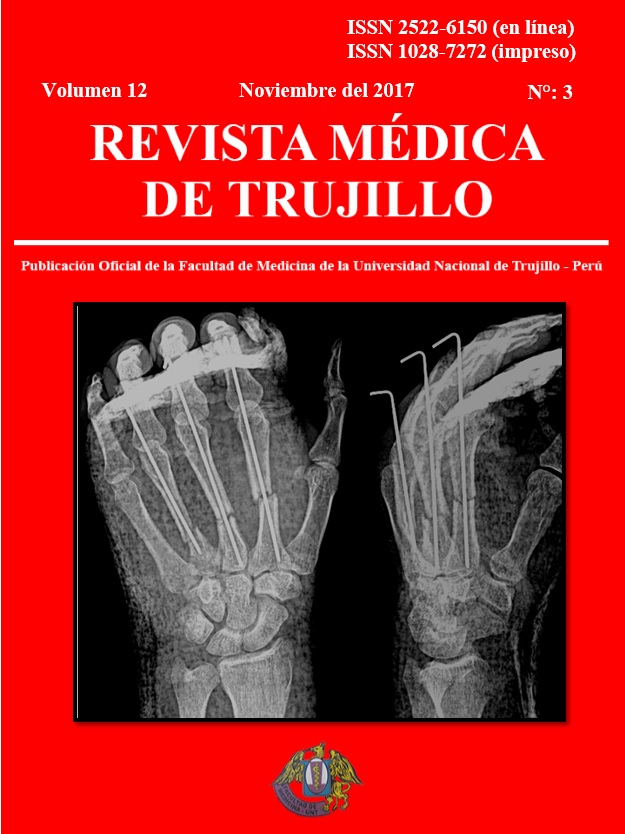Complicaciones cardiovasculares y cifras de presión sistólica en hipertensos no diabéticos mayores de 50 años
Abstract
Objetivo. Determinar la frecuencia de complicaciones cardiovasculares según las cifras de presión sistólica en pacientes hipertensos no diabéticos mayores de 50 años. Métodos. Se realizó un estudio observacional y retrospectivo en 91 pacientes hipertensos del hospital I Florencia de Mora. Resultados. 54% mujeres, edad promedio 68 ± 8,81 años. El tiempo desde el diagnóstico promedió 10,6 ± 3,76 años. El número de antihipertensivos por paciente fue 1,4 en promedio, con 49% que usaron un solo antihipertensivo y 43% que usaron dos antihipertensivos. 60,4% recibieron bloqueadores de receptores de angiotensina en monoterapia o como primer antihipertensivo. La cifra promedio de presión arterial sistólica (PAS) al inicio del estudio (5años) fue de 153,2 ± 12,73 mm Hg. y al finalizar el estudio fue de 121,63 ± 10,38 mmHg. 33% de hipertensos alcanzaron una cifra de PAS menor de 120 mmHg. 35,2 % alcanzaron cifras de PAS entre 120 y 129 mmHg. Se presentaron complicaciones en 20,9% de pacientes. De ellos, se presentó complicación cardiovascular en un paciente con cifras de PAS menor a 120 (3,33%) y en el 29,5% de los que alcanzaron cifras de PAS > 120 mmHg. RR:0.26 (IC 95% 0.13-0.39). Conclusiones. Las complicaciones cardiovasculares son menos frecuentes (3,3%) cuando la cifra de presión arterial sistólica es menor de 120 mm Hg
PALABRAS CLAVE: hipertensión. presión arterial. presión sistólica. complicaciones cardiovasculares
References
WHO/DCO/WHD/2013.2. Disponible en
www.who.int/cardiovascular_diseases/publications/global_brief_hypertensio/en/
Segura L, Agusti R, Parodi J. Factores de riesgo de las enfermedades cardiovasculares
en el Perú (Estudio TORNASOL). Rev Peruana de Cardiología 2006;32(2):82-128
Segura L, Agusti R, Ruiz E. La hipertensión arterial en el Perú según el estudio TORNASOL II. Rev Peruana Cardiología 2011;37(1):19-27
The 7th Report of the joint comitee on prevention, detection, evaluation and treatment of high blood pressure. JAMA May 21, 2003; 289(19):2560-2572
Chobanian A. Isolated Systolic hypertension in the Elderly. NEJM 2007;357(8):789-96.
Klingbeil. A meta-analysis of effects of treatment on left ventricular mass in essential hypertension. Am J Med 2003;115:41-6.
Jamerson K, Webwr M, Bakris G, Dahlof B, Pitt B, Shi V et al. Benazepril plus amlodipine or hydrochlorothiazide for hypertension in high-risk patients. N Engl J med 2008;359(23):2417-28.
Baguet J, Legallicier B, Auquier P and S. Robitail. Updated Meta-Analytical Approach to the Efficacy of Antihypertensive Drugs in Reducing Blood Pressure. Clin Drug Invest 2007; 27 (11): 735-753.
Camacho L. Tendencias en el uso de antihipertensivos en un programa de hipertensión. Universidad Nacional de Trujillo Cbas-Med 2004.
Sherril B, Halpern M, Khan S, Zhang J, Panjabi S. Single-pill vs free-equivalent combination therapies for hypertension: a meta-analysis of health care costs and adherence. J Clin Hypertens (Greenwich) 2011;13(12):898-909.
Álvarez-Vargas ML, Galvez-Olortegui JK, Galvez-Olortegui TV, Sosa-Rosado JM, Camacho-Saavedra LA. Revisión de las guías actuales de hipertensión arterial. Medwave [Internet]. 2015 Oct [cited 2015 Oct 23];15(09). Available from: /link.cgi/Medwave/Revisiones/RevisionClinica/6290
James PA, Oparil S, Carter BL, Cushman WC, Dennison-Himmelfarb C, Handler J, et al. 2014 evidence-based guideline for the management of high blood pressure in adults: report from the panel members appointed to the Eighth Joint National Committee (JNC 8). JAMA [Internet]. 2014 Dec;311(5):507–20. Available from: http://www.ncbi.nlm.nih.gov/pubmed/24352797
Mancia G, Fagard R, Narkiewicz K, Redon J, Zanchetti A, Böhm M, et al. 2013 ESH/ESC Practice Guidelines for the Management of Arterial Hypertension. Blood Press [Internet]. 2014;23(1):3–16. Available from: http://content.wkhealth.com/linkback/openurl?sid=WKPTLP:landingpage&an=00004 872-201307000-00002
Daskalopoulou SS, Rabi DM, Zarnke KB, Dasgupta K, Nerenberg K, Cloutier L, et al. The 2015 Canadian Hypertension Education Program Recommendations for Blood Pressure Measurement, Diagnosis, Assessment of Risk, Prevention, and Treatment of Hypertension. Can J Cardiol [Internet]. 2015 May;31(5):549–68. Available from: http://gw2jh3xr2c.search.serialssolutions.com?url_ver=Z39.88-2004&rft_val_fmt=info:ofi/fmt:kev:mtx:journal&rfr_id=info:sid/Ovid:prem&rft.genre =article&rft_id=info:doi/10.1016/j.cjca.2014.02.002&rft_id=info:pmid/24786438&rft. issn=0828-282X&rft.volume=30&rf)
Sanchez R a, Ayala M, Baglivo H, Velazquez C, Burlando G, Kohlmann O, et al. Latin American guidelines on hypertension. Latin American Expert Group. J Hypertens [Internet]. 2009 May [cited 2013 Aug 6];27(5):905–22. Available from: http://www.ncbi.nlm.nih.gov/pubmed/19349909
Ruiz E, Segura L, Rodriguez J. Guía de Diagnóstico y Tratamiento de la hipertensión “De la teoría a la práctica”. Sociedad Peruana de Cardiología 2011.
The SPRINT Research Group. A Randomized Trial of Intensive versus Standard Blood-Pressure Control. N Engl J Med. 2015 2015;373:2103-2116.
Chobanian A. time to reassess blood pressure goals. N Engl J Med 2015;373(22):2093-95
Sauza-Sosa J, Romero-Figueroa J, Sierra-Galán L, Ferez-Santander S. Porqué es importante lograr metas de hipertensión arterial sistémica. Arch Cardiol Mex. En prensa 2015.
Yeh J, bakris J, Taler S. Blood pressure control (Clinical decisions). N Engl J Med 2015;373(22):2180-82
Drazner M. The progression of hypertensive heart disease. Circulation. 2011;123:327-334
Kahan T, Bergfeldt L. left ventricular hypertrophy in hypertension: its arrhythmogenic
potential. Heart 2005; 91:250–256. doi: 10.1136/hrt.2004.042473.
Bress A, Tanner R, Hess R, Colantonio L, Shimbo D, Muntner P. Generalizability of
SPRINT Results to the U.S. Adult Population. J Am Coll Cardiol. 2016;67(5):463-472.
Vidal-Petiot E, Ford I, Greenlaw N, Ferrari R, Fox KM, Tardif JC, Tendera M, Tavazzi L, Bhatt DL, Steg PG; CLARIFY Investigators. Cardiovascular event rates and mortality according to achieved systolic and diastolic blood pressure in patients with stable coronary artery disease: an international cohort study. Lancet. 2016;388:2142-2152.










